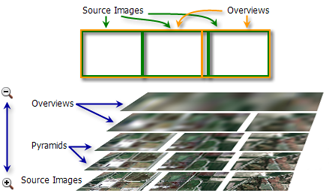This is a very common question that many users ask. First let’s take a look at what each of these, and when they are needed.
Pyramids
Pyramids are reduced resolution datasets. They let you perform dynamic mosaicking and on-the-fly processing quickly, even at smaller scales with little effect on performance. Pyramids are built for primary (source) rasters that are on disk. `Viewing and processing these raw rasters on-the-fly can be time-consuming at small scales, therefore we build pyramids for this reason.
Overviews
Overviews are similar to pyramids in the sense that they are reduced resolution images created to optimize your mosaic dataset for performance and increase display speeds. However, the biggest distinguishing factor here is that the overviews are not created per raster. Each overview is derived by mosaicking multiple primary rasters. Since each overview was derived from multiple rasters, it takes a static view of the mosaic dataset at the time you generate overviews. Creating overviews will mean that the dynamic mosaicking capabilities are not longer available.
When are pyramids per mosaic dataset item needed
You should consider building pyramids when you are building more complex mosaic datasets, especially where you will be taking advantage of the mosaic methods and on-the-fly processing, then it will be advantageous to build pyramids on the source rasters and to build overviews only where they are needed.
When are overviews needed in a mosaic dataset
You should consider building overviews when you are working with: tiled images, preprocessed images, butt-joined (non-overlapping) imagery, basically imagery that wont be really affected by changing mosaic methods. But one thing to keep in mind, overviews do not retain the primary rasters metadata.
Contributed by: Vinay Viswambharan

Commenting is not enabled for this article.